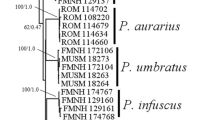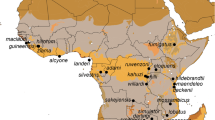Abstract
A phylogeny of least sac-winged bats (Balantiopteryx) was constructed from morphological data, and molecular data derived from mapped restriction cleavage sites of the 2,400 base pair mtDNA gene region including ND3, ND4L, and ND4. Separate and combined phylogenetic analyses each gave single most-parsimonious solutions with a well supported topology of (B. plicata, (B. io, B. infusca)). Incorporating current distribution patterns and habitat preferences with our phylogeny and estimates of divergence suggests that speciation within Balantiopteryx occurred in the Late Miocene prior to the establishment of the Isthmian Link between South and North America. Based on the premise that the genus arose in insular South America, we hypothesize that ancestral Balantiopteryx dispersed overwater to Middle America and that B. plicata subsequently diverged in the dry Pacific versant of Middle America after tectonic uplifting. B. io and B. infusca subsequently speciated allopatrically in the wet Atlantic versant of southern Mexico and northern Central America, and in the Pacific versant of southwestern Colombia and northwestern Ecuador, respectively, prior to the present land connection between North and South America.
Zusammenfassung
Eine Phylogenie der kleinen Sackflügelfledermäuse (Balantiopteryx) wurde an Hand von morphologischen sowie molekularen Daten erstellt. Der molekulare Datensatz bestand aus kartierten Restriktionsschnittstellen der mtDNA-Genregion (2,400 Basenpaare einschließlich von ND3, ND4 l und ND4). Sowohl getrennte als auch gemeinsame phylogenetische Analysen ergaben jeweils eine einzige parsimone Lösung mit folgender, gut unterstützter Topologie: (B. plicata, (B. io, B. infusca)). Berücksichtigt man die gegenwärtigen Verbreitungsmuster und Habitatpräferenzen in unserer Phylogenie sowie Abschätzungen der Divergenz, so legt dies nahe, daß die Artbildung von Balantiopteryx im späten Miozän vor der Entstehung der Isthmusverbindung zwischen Süd- und Nordamerika erfolgte. Ausgehend von der Annahme, daß die Gattung in Südamerika vor der Kontinentalverbindung entstand, stellen wir die Hypothese auf, daß sich ursprüngliche Balantiopteryx über Wasser nach Mittelamerika ausbreiteten und daß in Folge tektonischer Auffaltung B. plicata entlang der trockenen, pazifischen Abhänge von Mittelamerika evolvierte. Die beiden anderen Arten entstanden anschließend vor der heutigen Landverbindung zwischen Nord- und Südamerika in Allopatrie: B. io entlang der feuchten, atlantischen Abhänge des südlichen Mexiko und des nördlichen Mittelamerika sowie B. infusca entlang der pazifischen Abhänge des südwestlichen Kolumbien und nordwestlichen Ekuador.
Similar content being viewed by others
References
Arroyo-Cabrales, J.; Jones, Jr., J. K. (1988a): Balantiopteryx plicata. Mammalian Species 301, 1–4.
Carroyo-Cabrales, J.; Jones, Jr., J. K. (1988b): Balaniopteryx io and Balantiopteryx infusca. Mammalian Species 313, 1–3.
Barghoorn, S. F. (1977): New material of Vespertiliavus Schlosser (Mammalia, Chiroptera) and suggested relationships of emballonurid bats based on cranial morphology. Amer. Mus Novitates 2618, 1–29.
Brown, W. M. (1985): The mitochondrial genome of animals. In: Molecular Evolutionary Genetics. Ed. by R. J. Macintyre. New York: Plenum Press. Pp. 95–130.
Cronin, M. A.; Spearman, W. J.; Wilmot, R. L.; Patton, J. C.; Bickham, J. W. (1993): Mitochondrial DNA variation in chinook (Oncorhynchus tshawytscha) and chum salmon (O. keta) detected by restriction enzyme analysis of polymerase chain reaction (PCR) products. Can J. Fish Aquat Sci. 50, 708–715.
Dalquest, W. W. (1953): Mammals of the Mexican state of San Luis Potosi. Louisiana State Univ. Studies 1, 1–229.
Dalquest, W. W.; Roth, E. (1970): Late Pleistocene mammals from a cave in Tamaulipas, Mexico. Southwestern Naturalist 15, 217–230.
Dunlop, J. M. (1998): The evolution of behaviour and ecology in Emballonuridae (Chiroptera). Diss. thesis, York University, North York, Ontario.
Engel, S. R.; Hogan, K. M.; Taylor, J. F.; Davis, S. K. (1998): Molecular systematics and paleobiogeography of the South American sigmodontine rodents. Mol. Biol. Evol. 15, 35–49.
Goodwin, G. G. (1967): Mammals from the state of Oaxaca, Mexico, in the American Museum of Natural History. Bull. Amer. Mus. Nat. Hist. 141, 1–269.
Griffiths, T. A.; Smith, A. L. (1991): Systematics of emballonurid bats (Chiroptera: Emballonuridae and Rhinopomatidae), based on hyoid morphology. Bull. Amer. Mus. Nat. Hist. 206, 62–83.
Hershkovitz, P. (1968): The recent mammals of the Neotropical region: a Zoogeographie and ecological review. Quart Rev. Biol. 44, 1–70.
Hill, J. E. (1986): A note on Balantiopteryx infusca (Thomas, 1897) (Chiroptera: Emballonuridae). Mammalia 50, 558–560.
Jones, K. E.; Purvis, A.; Maclarnon, A.; Bininda-Emonds, O. R.; Simmons, N. B. (2002): A phylogenetic supertree of the bats (Mammalia: Chiroptera). Biol. Rev. 77, 223–259.
Koopman, K. F. (1984): Bats. In: Orders and Families of Recent Mammals of the World. Ed. By S. Anderson and J. K. Jones, Jr. New York: John Wiley and Sons. Pp. 145–186.
Lim, B. K.; Engstrom, M. D. (1998): Phylogeny of Neotropical short-tailed fruit bats, Carollia spp.: phylogenetic analysis of restriction site variation in mtDNA. In: Bat Biology and Conservation. Ed. by T. H. Kunz and P. A. Racey. Washington, DC: Smithsonian Inst. Press. Pp. 43–58.
Mccarthy, T. J.; Albuja V. L.; Manazano, I. (2000): Rediscovery of the brown sac-wing bat, Balantiopteryx infusca (Thomas, 1897), in Ecuador. J. Mammalogy 81, 958–961.
Morales, J. C.; Patton, J. C.; Bickham, J. W. (1993): Partial endonuclease digestion mapping of the restriction sites using PCR-amplified DNA. PCR Methods Applications 2, 228–233.
Myers, N.; Mittermeier, R. A.; Mittermeier, C. G.; Da Fonseca, A. B.; Kent, J. (2000): Biodiversity hotspots for conservation priorities. Nature 403, 853–858.
Nei, M.; Li, W.-H. (1979): Mathematical model for studying genetic variation in terms of restriction endonucleases. Proc. Natl. Acad. Sci., USA 76, 5269–5273.
Patterson, B.; Pascual, R. (1968): The fossil mammal fauna of South America. Quart. Rev. Biol. 43, 409–451.
Reid, F. A. (1997): A Field Guide to the Mammals of Central America and Southeast Mexico. New York: Univ. Oxford Press.
Robbins, L. W.; Sarich, V. M. (1988): Evolutionary relationships in the family Emballonuridae (Chiroptera). J. Mammalogy 69, 1–13.
Savage, J. M. (1974): The isthmian link and the evolution of Neotropical mammals. Contrib. Sci., Nat. Hist. Mus. Los Angeles County 260, 1–51.
Simmons, N. B. (2003): Chiroptera. In: Mammal Species of the World: A Taxonomic and Geographic Reference, Third Edition. Ed. by D. E. Wilson and D. M. Reeder. Washington, DC: Smithsonian Inst. Press (in press).
Swofford, D. L. (1998): PAUP*: phylogenetic analysis using parsimony (*and other methods), version 4.0b4a. Sunderland, Massachusetts: Sinauer Associates.
Thomas, O. (1897): Descriptions of new bats and rodents from America. Ann. Mag. Nat. Hist. 6(20), 544–553.
Thomas, O. (1904): New forms of Saimiri, Saccop-teryx, Balantiopteryx, and Tricomys from the Neotropical region. Ann. Mag. Nat. Hist 7(13), 250–255.
Webb, S. D. (1976): Mammalian faunal dynamics of the great American interchange. Paleobiology 2, 220–234.
Webb, S. D. (1999): Isolation and interchange: a deep history of South American mammals. In: Mammals of the Neotropics: the Central Neotropics, Vol. 3, Ecuador, Peru, Bolivia, Brazil. Ed. by J. F. Eisenberg and K. H. Redford. Chicago: Univ. Chicago Press. Pp. 13–19.
Wilson, A. C.; Cann, R. L.; Carr, S. M.; George, M.; Gyllensten, U. B.; Helm-Bychowski, K. M.; Higuchi, R. G.; Palumbi, S. R.; Prager, E. M.; Sage, R. D.; Stoneking, M. (1985): Mitochondrial DNA and two perspectives on evolutionary genetics. Biol. J. Linn. Soc. 26, 375–400.
Author information
Authors and Affiliations
Corresponding author
Rights and permissions
About this article
Cite this article
Lim, B.K., Engstrom, M.D., Simmons, N.B. et al. Phylogenetics and biogeography of least sac-winged bats (Balantiopteryx) based on morphological and molecular data. Mamm Biol 69, 225–237 (2004). https://doi.org/10.1078/1616-5047-00139
Received:
Published:
Issue Date:
DOI: https://doi.org/10.1078/1616-5047-00139




